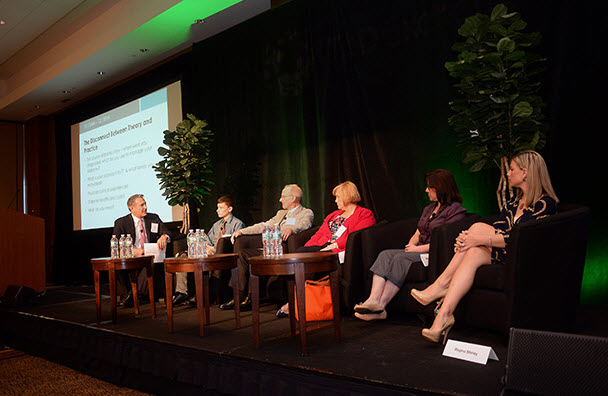
Blog | 5/20/2015
Insights from the T1D Exchange Annual Meeting
Sheela Hegde interviews Nayna Aggarwal on her experience at the recent T1D Exchange Annual Meeting.
Sheela: Nayna, you attended the T1D Exchange Annual Meeting last week, a unique forum in the diabetes industry. Can you explain what the T1D Exchange is and what this meeting is about?
Nayna: T1D Exchange is a non‑profit initiative focusing on type 1 diabetes. The annual meeting is focused on patient‑centric care and innovation.
Sheela: It's interesting that you bring up the patient‑centric theme. It is a theme relevant to many areas, but particularly important to diabetes because of the level of the patient engagement required in their own self‑care. Can you highlight for us some of the patient forums that were in the conference and what you took away from them?
Nayna: The day started with a patient panel. It was a mix of men and women of all different ages. I thought it was very powerful to hear their perspectives on some of the challenges with managing their type 1 diabetes, how it's affected their career decisions, their family life, and so on. At Health Advances, we are always thinking about the patient perspective as we advise our clients. It's wonderful to hear first‑hand some of the issues that patients directly deal with and what they would like to see improved.
Sheela: Can you give us some examples of the issues patients are wrestling with?
Nayna: Sure. One theme that we've heard for years now is around coverage of some of the emerging therapies and technologies for type 1 diabetes. There are certain therapies or technologies such as CGM, or continuous glucose monitoring, which are covered today by some private plans. But as patients get older and go into Medicare, then CGM is not covered anymore. Patients worry that their access to CGM technology will go away once they hit 65. Then what will they do? They have gotten so used to managing their diabetes using CGM. That was one theme. Another theme that came up during the patient panel was access to providers who are knowledgeable about type 1 diabetes and concerns around whether providers really understand what patients go through on a day‑to‑day basis. The last theme was around the burden patients face in managing their lives with the therapies that are available today. If there are solutions that would simplify life with type 1 diabetes, they would be very appreciated.
Sheela: That is a great recap of the issues that type 1 diabetes patients face. Shifting gears, tell us what you learned on the technology innovation front. Were there any novel technologies that were featured at this year's conference?
Nayna: One central topic was around some of the digital solutions that are emerging to help physicians communicate with their patients remotely and to help patients track and log how their treatment is going. There are a number of applications being developed. The other topic was around the search for cell therapy solutions, which are still several years out, given some of the research challenges. There was also an update from the T1D Exchange's patient community, Glu.
Sheela: Tell us more about Glu.
Nayna: Glu is a growing online type 1 patient community. One thing that patients really like about Glu is that they're able to see how other people with type 1 diabetes are managing their disease. It's also helpful for people in industry and researchers to get feedback from patients as they develop new therapies or to just better understand unmet patient needs.
Sheela: In this update, was any data shared directly from the Glu community?
Nayna: They were sharing more qualitative feedback from patients. Some of the data they shared from the Exchange was really interesting to see. Some of the trends in HbA1C levels over time and also by age group as some of the technologies have been adopted more broadly, technologies such as CGM. The Exchange had studies showing better control among patients who are on a CGM along with their multiple daily injection therapy versus those who are not. I think that data ties back to the first topic I mentioned around access to CGM. The data is really supporting CGM, so patients and others are really trying to push that forward in terms of broader access. The Exchange collects this data from a number of centers and is able to do longitudinal analyses. That's been a powerful tool to help others in the industry understand some of the trends and remaining issues among certain age segments or at certain points in life. That ties to another theme that came up throughout the day around some of the psychosocial impact of having type 1 diabetes, and how that's not really a part of the standard treatment algorithm for a patient. That's another area that I think more people are trying to be aware of, but is just beginning to be talked about. Overall, I would say it was a fantastic meeting. It was very energizing to have folks from industry, from the research field, and patients, of course, being in one room and dialoguing on important issues. Everyone left feeling like we've made great progress, but there's still a lot to be done.
Opinions expressed here are solely those of the authors and do not reflect the views of Health Advances LLC, its management, or affiliates

